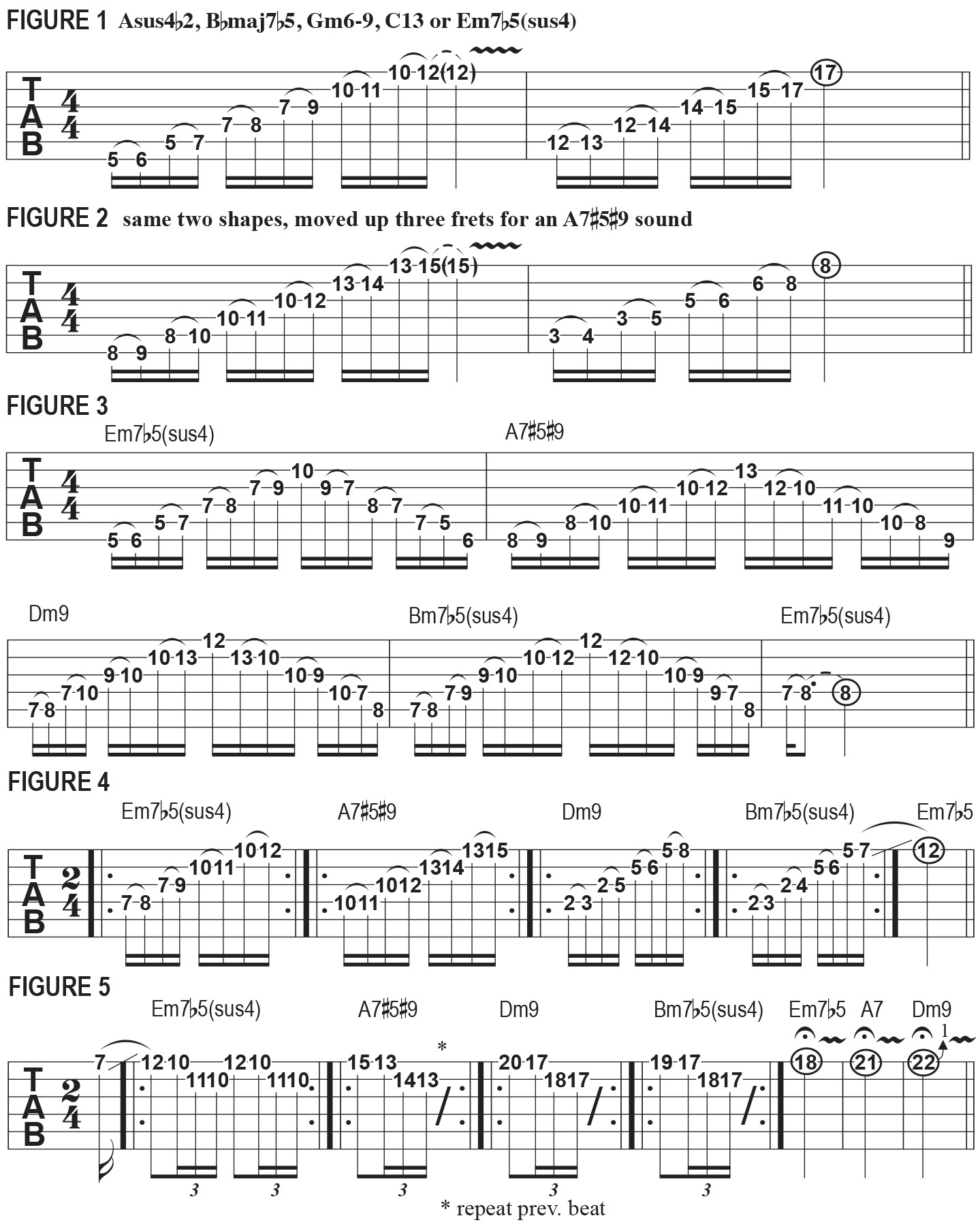Two Additional, Musically Haunting Uses for Maj7b5
Today I’m going to present another two interesting and intriguing ways to repurpose the sus4b2, or maj7b5, arpeggio shapes that we’ve been working with in the previous three lessons (GW November, December and Holiday 2017 issues) and show you how to use them to create harmonically tense and haunting sounds that convey dark, jazz-flavored chord qualities and voicings using single notes. I’ll then demonstrate some cool ways to apply these arpeggios to melodic patterns across a standard, four-chord minor-key progression.
For reference and review, FIGURE 1 depicts the two diagonal multi-octave fretboard paths I previously showed you for Asus4b2, each based on the four-note sequence A Bb D E, which then repeats in higher octaves. If we were to play either of these patterns again but change our accompanying bass note from A to Bb, or to C or G, the tonality then changes to Bbmaj7b5, C13, or Gm6-9, respectively.
Now, if we were to change the bass note to E, which is a tritone away from Bb—meaning three whole steps above or below—we get a darkly dramatic Em7b5(sus4) sound, with A being heard as the fourth, Bb as the flat-five, D as the flat-seven and E as the root. The minor third, G, is not actually played here but is implied in context.
So that’s one new use for our four-note arpeggio shape—to get a m7b5 sound with a sus4. The other new use I spoke of is presented in FIGURE 2 and creates what’s known as an altered dominant sound, which is a tension-filled dominant seven arpeggio (or chord) that has both a raised, or “sharp-ed,” fifth and ninth (7#5#9).

What we’re doing in this example is going back to an A bass note and moving, or transposing, our four-note melodic shapes up a minor third (three frets) and, in bar 2, down an octave and 12 frets, for more comfortable fretting in a lower position. You may find it helpful to think of these arpeggios as being either Csus4b2 (C Db F G) played over A, or Dbmaj7b5 (C#maj7b5) over A. In any case, relative to an A root, C is heard as the sharp nine (theoretically B#), C# is the major third, F is the sharp five (E#) and G is the flat seven.
Now let’s look at some cool applications of our two new arpeggio flavors, applied to a standard II-V-I-VI (two-five-one-six) chord progression in the key of D minor: Em7b5-A7#5#9-Dm9-Bm7b5. FIGURE 3 has you ascending and descending in 16th notes through each arpeggio across two octaves, employing hammer-ons and pull-offs liberally (feel free to pick more of the notes). Notice in bar 3 that we’re using an Fmaj7 shape, starting on the seventh—E F A C—to get a Dm9 sound. In bar 4, we take the same pattern from bar 3 and drop each C note to B, to get an Fmaj7b5 arpeggio (or Esus4b2), which, over a B bass note, creates a Bm7b5sus4 sound.
Picking up where FIGURE 3 leaves off, FIGURE 4 is a simpler variation on the same melodic pattern, in which we’re only ascending through each arpeggio across the top four strings, which, without any pull-offs, is an easier pattern to play.
FIGURE 5 is an alternate-picking variation that uses four-note “shred cells” across the top two strings only and with a different melodic contour—descending—and rhythmic phrasing scheme—an eighth note followed by a 16th-note-triplet “semi-automatic machine gun burst” (“ba-ga-dat”).
Experiment and have fun with these various arpeggio patterns and shapes and try applying them in other keys and tonal centers in different areas of the fretboard.
Get The Pick Newsletter
All the latest guitar news, interviews, lessons, reviews, deals and more, direct to your inbox!
Over the past 30 years, Jimmy Brown has built a reputation as one of the world's finest music educators, through his work as a transcriber and Senior Music Editor for Guitar World magazine and Lessons Editor for its sister publication, Guitar Player. In addition to these roles, Jimmy is also a busy working musician, performing regularly in the greater New York City area. Jimmy earned a Bachelor of Music degree in Jazz Studies and Performance and Music Management from William Paterson University in 1989. He is also an experienced private guitar teacher and an accomplished writer.
“There are so many sounds to be discovered when you get away from using a pick”: Jared James Nichols shows you how to add “snap, crackle and pop” to your playing with banjo rolls and string snaps
Don't let chord inversions bamboozle you. It's simply the case of shuffling the notes around








![Joe Bonamassa [left] wears a deep blue suit and polka-dotted shirt and plays his green refin Strat; the late Irish blues legend Rory Gallagher [right] screams and inflicts some punishment on his heavily worn number one Stratocaster.](https://cdn.mos.cms.futurecdn.net/cw28h7UBcTVfTLs7p7eiLe.jpg)


